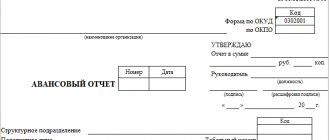Report on changes in capital: who must submit it and when?
Who submits the report on changes in capital is indicated in the order of the Ministry of Finance of the Russian Federation dated July 2, 2010 No. 66n. According to this legislative and regulatory act, Form No. 3 must be submitted by large and medium-sized organizations created through the formation of authorized capital, which issued shares that do not use a simplified version of accounting.
Small enterprises have the right not to generate or submit this type of reporting to government agencies, since it is not included in the list of submitted reporting forms.
The document must be submitted to the tax service and statistical authorities no later than 3 calendar months after the end of the reporting period, that is, the calendar year.
Who should take it?
Form 3 must be completed by all organizations that do not fall into the following categories:
- small business organizations that prepare and submit financial statements in a simplified format (such entities must submit only a balance sheet and financial statements);
- budget structures;
- Insurance companies;
- credit institutions.
Thus, a report on the dynamics of available capital must be compiled by enterprises that simultaneously meet the following requirements:
- They are legal entities.
- Refers to medium/large businesses.
- To create them, an authorized capital was formed or, as an option, shares were issued.
- They do not use a simplified approach to the preparation/submission of annual financial statements, but submit official (annual) statements exclusively in the full version, which implies the mandatory preparation of forms 1, 2, 3, and 4.
Accounting statements for 2021:
- balance (form 1);
- statement of financial results (form 2);
- cash flow statement (form 4);
- simplified financial reporting for small businesses.
Deadlines and place of submission in 2021 for organizations
The report is part of the full set of annual reporting documents submitted by the business entity annually.
Thus, a report on changes in the organization’s existing capital must be generated and submitted within a three-month period, counted from the first day (01.01) of the year following the reporting period.
According to the general rule, if the last day of the deadline for submitting reporting documents falls on a holiday/weekend, it must be postponed (shifted) to the nearest weekday following the non-working day.
So, for example, Form 3 for the past 2021 will need to be submitted no later than 04/01/2019.
Like other documents of the annual financial statements of a business entity, this report must be submitted in separate copies to two controlling structures:
- territorial division of the tax service operating at the place of official registration of the taxpayer company;
- territorial division of the statistical agency operating at the place of residence of the legal entity.
What form do I need to fill out for 2021?
Form 3 refers to annual reporting documents submitted in an extended (full) version. It is considered an addition to the balance sheet/OFR - the main reports that require mandatory completion.
Forms (templates) of all forms - both basic (1,2) and additional (3,4,6) - are regulated by a special act of the Ministry of Finance of the Russian Federation.
Thus, a report on the dynamics of the existing capital of a business entity is drawn up and filled out in strict accordance with the above-mentioned act.
Download the current form for 2021 - word, excel.
Filling out a statement of changes in capital for 2021: rules, features
The procedure for filling out a report on changes in capital 2017 involves entering information into several sections of the document, namely:
- basic information about the company. Such information includes the name of the enterprise, tax identification number, type of economic activity, type of organizational and legal form, as well as the unit of measurement (thousand or million rubles);
- movement of capital. This section is the most voluminous, since it contains all the basic information about the company’s capital, its changes over the period and by type;
- adjustments. If it is necessary to make any adjustments for the previous period when accounting errors are identified or accounting policies are changed, this section is used. In this case, the values should be indicated both before and after changes are made;
- net assets. Net assets refers to the difference between an organization's assets and liabilities. Its value is determined using the Order of the Ministry of Finance of the Russian Federation “On approval of the Procedure for determining the value of net assets” dated August 28, 2014 No. 84n.
Report writing rules
This report has a unified standard form recommended for use. The form can be expanded and supplemented based on the needs of the enterprise. The document contains:
- Company details,
- detailed information on the movement of three types of capital:
- additional,
- reserve,
- statutory,
- data on the share of the company's own shares,
- adjustments caused by changes in the company's accounting policies,
- information on changes in the amount of retained income and uncovered losses of the organization, etc.
Statement of changes in capital (filling example)
In order to fill out a document, you can Word “Report on Changes in Capital” and fill it out manually, or generate and download it from a specialized accounting program, having previously checked for correctness of completion.
When learning about how to fill out a statement of changes in equity, you should understand what the specific lines include:
Section I "Movement of capital"
- According to the previous reporting year
- line 3100 – the amount of capital balance by type as of January 1 of the previous year;
- line 3210 – increase in capital for specific types of gain (pages 3211-3216 revaluation of property, additional issue of shares, net profit, reorganization of the enterprise, increase in the par value of securities);
- line 3220 – reduction of capital by specific types of reduction (pages 3221-3227 revaluation of property, reduction in the volume of securities and reduction in their nominal value, reorganization of the enterprise, payment of dividends);
- line 3230 – changes in additional capital;
- line 3240 – changes in reserve capital;
- By reporting year
- line 3200 – the amount of capital balance by type as of December 31 of the previous year;
- line 3310 – increase in capital for specific types of increase (pages 3311-3316 revaluation of property, additional issue of shares, net profit, reorganization of the enterprise, increase in the par value of securities);
- line 3320 – reduction of capital by specific types of reduction (pages 3321-3327 revaluation of property, reduction in the volume of securities and reduction in their par value, reorganization of the enterprise, payment of dividends);
- line 3330 – changes in additional capital;
- line 3340 – changes in reserve capital;
- line 3300 – the amount of capital balance by type as of December 31 of the reporting year.
Section II Adjustments
This section reflects adjustment information, namely:
- line 3400 of the statement of changes in capital - to reflect the value obtained without taking into account adjustments;
- line 3401 – including for retained earnings;
- line 3402 – including for other types of capital;
- lines 3410, 3411, 3412 – adjustments related to changes in accounting policies;
- lines 3420, 3421, 3422 – adjustments related to correcting found errors;
- line 3500 – to reflect the value obtained after adjustments;
- line 3501 – including for retained earnings;
- line 3502 – including for other types of capital.
Section II of the statement of changes in equity contains information as of the end of the preceding prior year, changes in the prior year, and as of the end of the prior year.
Section III Net Assets
In this section, line 3600 of the statement of changes in capital contains specific information on this indicator, divided at the end of three reporting periods - the current and two previous ones. To reflect net assets in the statement of changes in capital under Section III, it is necessary to subtract the amount of all its liabilities from the value of all assets of the enterprise.
Reflection of additional and reserve capital in the report
Cash as part of additional capital is accounted for in account 83. The main feature of filling out the column “Additional capital” is the reflection of indicators that affect its overall value. Moreover, the inter-reporting period from December 31 of the previous year to January 1 of the reporting year is taken as the period under consideration. This procedure is established due to the rules for revaluation of fixed assets: data received as of January 1 of the new year must be indicated as of December 31. previous year. For example, when revaluing as of 01/01/16. the date for the report will be 12/31/15.
The indicator is determined based on loan turnover data when interacting with accounts:
- accounting for cash and settlements when creating a positive exchange rate difference;
- accounting for financial results (account 91) when a negative exchange rate difference is formed;
- 75 on the amounts of the founders’ contribution to the property of the enterprise.
Accounting for reserves is kept on the account. 82. The document indicates data on the amount of deductions in the reporting and two previous periods. Reserve capital is formed from retained earnings in order to pay off expenses in cases where it is impossible to pay them from net income.
Example of filling out a statement of changes in capital 2021
To better understand how to fill out the statement of changes in equity (Form 3), let's look at a specific example. We will need information to complete the statement of changes in equity form for the reporting and previous periods.
PJSC "Rassvet" began its activities in 2021. Initial data (rub.):
| Indicators | 2016 | 2017 |
| Authorized capital | 50 000 | |
| Net profit | 70 000 | |
| Aimed at increasing reserve capital | 40 000 | |
| An additional issue of shares was carried out, increasing the authorized capital | 20 000 | |
| Additional capital was created by issuing shares and selling them in excess of their nominal value | 30 000 | |
| retained earnings | 90 000 | |
| Error in calculating retained earnings (overstatement) for 2016, discovered in 2021. | 10 000 | |
| Net assets | 90 000 | 120 000 |
Sample of filling out a report on changes in capital:
Report structure
The report consists of a title page and three tables in which accounting data will be reflected.
- The title page contains registration information about the reporting economic entity. Here you should indicate the reporting period, the full name of the organization, its INN, KPP, type of economic activity (code) and OKPO, register the organizational and legal form, and also indicate the form of ownership.
- The first table, “Capital Movements,” contains information grouped by type of capital and by methods of change in recent years. In this section it is necessary to reflect systematic information on turnover and capital balances in the accounting accounts.
- The second table “Adjustments due to changes in accounting policies and correction of errors” provides information on changes in the amount and structure of capital. Moreover, in the second block of the reporting form, not all changes should be indicated, but only those that are due to adjustments to the company’s accounting policies, which resulted in the recalculation of indicators. This block also reflects errors identified in accounting, the correction of which also adjusted the organization’s financial capital indicators.
- The third table, “Net Assets,” represents the value of the financial assets of the enterprise (for example, company property), which will remain at the disposal of the economic entity after the repayment of all debt obligations and debts. Read more about the procedure for calculating this indicator in the article “Net assets on the balance sheet”.
Report Definition
The form indicates three different characteristics:
- What type of capital do you have - additional, authorized, etc.
- Changes affecting capital - whether it decreased or, conversely, increased
- How exactly has capital changed over the past three years?
What is the main purpose of compiling such a report? The main thing here is to show how and in what way the financial condition of the company has changed over a certain period of time.
Due to the fact that the report reflects what changes in capital occurred in a specific period, based on these data it is possible to analyze changes in the financial organization in general and in particular. As a result, financiers can conclude what influenced the increase and decrease in capital.
Characteristics of the first part of the report
Section I of the third form contains information on all changes in the elements of the enterprise’s equity capital for the period under review. It includes: authorized, additional, reserve capital, as well as data on retained earnings (uncovered losses), shares purchased from the owners of the enterprise.
In each part, relevant indicators are indicated that can be compared with data from previous years. If the company has not changed its accounting policies, then the values will coincide with those included in the reports for the past 2 years. In case of changes, it is necessary to make adjustments to the data and indicate the reasons for the discrepancy in the explanatory note to the report.
Report Analysis
Analysis using this form is the only method that is carried out on a cash basis rather than an accrual basis. Only those transactions that have already taken place are indicated here, and not just those that are planned.
Finding these transactions is not difficult if you check the movements in the company's cash registers or bank accounts. Moreover, this method records what happens to monetary instruments over time - how easily financial instruments are converted into the money supply. Here, documents such as shares, bills acquired by the organization during the reporting period, securities and other financial instruments that are responsible for the liquidity of the company can be taken into account. Confirming the presence of such papers will also not be difficult.
That is why such a report is one of the most verifiable - it practically excludes the presence of fraud and the use of any subjective judgments. Accordingly, the value of analytics on such a document is very high, in addition, it can be used when forecasting transactions (for example, if an organization needs to attract borrowed capital, or if two companies are undergoing a merger into one).
So, who might need analytics using a report:
- The management of the company, since reporting allows you to understand how effectively the organization operates and the funds raised into it.
- To third parties - for example, an investor or shareholders. Based on the report, they will be able to draw conclusions about the liquidity of the company and whether it is possible to attract funds to this organization.
The types of analysis will depend on who is reviewing it and what its purpose is.
For example, if we are talking about an investor, then he will be interested in the flow of funds and how much the company is able to fulfill its obligations to creditors. As for the management, based on the data provided, they are interested in further business planning. However, both are interested in how efficiently the company operates and how fully the cash flow functions in the organization.
Such reporting is valued because it most clearly shows the dynamics of funds, and, at the same time, does not reflect those transactions that have not yet occurred. Thanks to this technique, the quality of research increases significantly, and it is easier to draw conclusions about the state of the company. Typically, analytics differ depending on the goals of the research being carried out, the type of activity of the organization and the characteristics of the industry.









